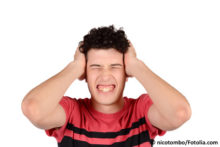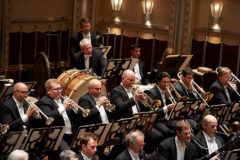No doubt you have, on occasion, noticed teenagers congregating (some would say loitering) in shopping malls, outside of movie theaters or convenience stores, or in parking lots. In 2005, after his 17-yr old daughter was bullied and harassed by a gang of teens outside a local convenience store, a man in Wales named Howard Stapleton came up with an idea to solve the problem. He invented a device emitting a high frequency that could be mounted outside the shop.  The sound would be so annoying to teenagers that they would leave rather than congregate outside.
The sound would be so annoying to teenagers that they would leave rather than congregate outside.
The sound was at a frequency of 17 kHz, which teens could hear, but adults could not because most people lose the ability to hear higher frequencies after their early 20s. So because adults could not hear the sound, they would do their shopping in peace. Teenagers who came to buy something would shop and leave, rather than submit themselves to the obnoxious sound by congregating outside. Nicknamed the Mosquito, the device has been sold throughout Europe and in the US, has been praised and promoted by many police departments, but is also in the crosshairs of several civil rights organizations.*
I read about it in the New York Times when the Mosquito was first unveiled. A link in the digital edition opened an audio clip of the 17.4 kHz sound so you could test yourself to see if you could hear it. Being a normal adult, I heard nothing.
We all lose the ability to hear higher frequencies as we age. But unfortunately, musicians, whose entire existence is about sound, are at greater risk than most for hearing disorders. One assumes that rock musicians might lose some hearing abilities. But it is classical musicians who are at the greater risk of developing work-related hearing disorders.
The relationship between hearing damage and exposure to sound has been studied in orchestral musicians for about 25 years. The European Union has long recognized the danger of environmental noise, and regulations stipulate that ear protection must be worn in any workplace where decibel levels exceed 85 dB, and that includes orchestras. Friends of mine who play in German orchestras report that, for years, they have worn ear protection provided by the German government.
If 85 dB is considered the threshold after which you are at risk with long exposure, consider this. Violins play in the range of 84 to 102 dB, flutes 85 to 111 dB, trombones 85 – 114 dB, and orchestral peaks range from 120 – 137dB – well beyond the safety threshold. Orchestral music isn’t quiet. You may have your own favorite loud orchestral work. New York classical music station WQXR has a list of their favorites (2011) for the top five loudest classical music compositions.

When I’m at an orchestra concert and the repertoire is particularly bombastic, I think,“wow, I wouldn’t want to be sitting in front of the trumpets or trombones.” And professional orchestras have experimented with various measures to reduce sound levels, such as placing screens between sections, creating more space between sections, or using risers. But a recent study shows that none of these measures to reduce sound levels significantly influences sound exposure because it turns out that the greatest risk comes from one’s own instrument, not that of others.
Acoustics expert, musician, and researcher Remy Wenmaekers at the Eindhoven University of Technology in the Netherlands used an acoustic prediction model he had developed to work out what the decibel level would be at ear level of musicians in various positions in an orchestra. He reported his findings in the November 2017 issue of The Journal of the Acoustical Society of America.
His model shows the sound levels experienced by musicians for the first two minutes of the 4th movement of Gustav Mahler’s Symphony No 1. The video below is not from his study, but if you don’t know the Mahler, or if you have forgotten the power of the last movement, you can listen to the 4th movement in a performance by the Los Angeles Philharmonic with Gustavo Dudamel conducting.
https://www.youtube.com/watch?v=IIykYnoKKt8
Using his model with this particular piece of music, Wenmaekers discovered that the sound-reducing measures that are usually used, such as screens or risers for different sections of the orchestra, were largely ineffective since the main source of sound was the player’s own instrument. He concluded that the only solutions are either to play quietly, which really is not an option, or to use ear plugs.
I’m on the Musicians’ Health Committee for the College Music Society (CMS), an organization of thousands of college and university music professors. One of my committee colleagues is Dr. Heather Malyuk, a musician and audiologist. I was stunned when Heather recently noted that ongoing research studies are beginning to show that many music students develop a hearing disorder before they become professionals. She speaks passionately about the need for musicians to be mindful of their ears, which she calls our “most valuable instrument.” A year ago, she presented a CMS webinar called Hearing Wellness for Music Educators. In this 20-minute webinar, she covers some basic anatomy of the ear, gives causes of hearing disorders for musicians and suggests some protective strategies. This is information that all musicians need to know and to act on – sooner rather than later.
The hearing environment for orchestral musicians has been studied far more than that of anyone who plays a solo instrument, but the problems are the same. Dr. Wenmaeker says that higher sound levels occur during individual practice than in orchestral rehearsals so he concludes that “most musicians are better off playing in the orchestra than rehearsing at home.” For most pianists like me, that’s not an option. We are solo or chamber music performers, we’re not playing with an orchestra, and we practice at home, in a studio or small rehearsal space. The piano registers in the range of 92 to 95 dB, so pianists are also experiencing sound levels that may sometimes be damaging to our hearing. All musicians, not just orchestral musicians, need to protect our “most valuable instrument,” our ears.
Meanwhile, back to the Mosquito. There are various sites online where you can check to see if you can hear the Mosquito frequency. But since I can’t hear the 17.4 kHz frequency, I have no way to know if it is actually there. I’ll leave you to check that out yourself.
And what about the teens who were being subjected to the Mosquito to prevent them from congregating? Teens retaliated by turning the frequency into a ringtone that only they could hear, thus being able to hear their cell phones in class when the teacher could not. That’s innovation!
#####
*Many people are concerned about the effect on young children and animals. My understanding is that the sound does not affect young children or animals because their hearing range is significantly higher than 17 kHz. It’s when the sound is at the upper edge of one’s hearing range that it is uncomfortable.
4 responses to “Musicians and hearing loss”
This issue of protecting one’s hearing is of the utmost importance and one that I have highlighted in my own blog. I’m still enjoying a long career as a professional musician but I am fortunate to have retained very acute hearing that extends to the range heard by young adults (according to results measured in a professionally administered hearing test).
I would be absolutely against using the mosquito in any context. I can hear it loud and clear and I find it not only excruciating as a sound, but extremely anxiety-provoking. I would be very worried on behalf any individual working in that environment and I believe that children and animals would be adversely affected by it.
Hi Sandy, Thanks for your comment. I have met other adults who can hear that frequency; unfortunately, I’m not one of them. I certainly wasn’t recommending the Mosquito in any context – just reporting on the issue. But it’s good to have your take on it. Thanks!
Fantastic article, just what we musicians needed. I’ve recommended using head phones when practicing for many years in my book (see below, section 61). When the ear hurts because of excessive loudness, it means that damage is being done, so we must worry if the mosquito isn’t damaging young ears. Wearing head phones when practicing at the piano has some interesting side effects. An inexpensive upright will sound more like a grand piano because most of the extraneous sounds are deadened! When you practice for a long time and then take the headphones off, you will be surprised at all the “non-musical” clatters, etc., that your piano makes. You never realized it because they were there all the time and you thought that it was all “normal”. You can hear the same mechanical sounds by playing on a digital piano and turning the sound off.
Hi, Thanks for writing. I have used headphones while trying to practice with a migraine (not very successfully), but in general find musicians ear plugs to be much more successful. You can change the attenuation – mine filter 15 dB, which is a lot for music. I plan to switch it to 9 dB. But it’s clear from the research that we musicians need to do more to protect our hearing. Thanks!